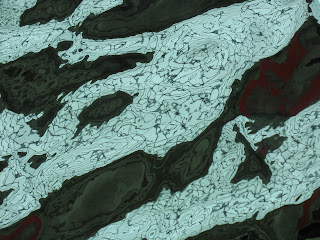My head is buzzing after an inspirational day up in town, at the Contemporary Quilt AGM and some serious retail therapy at London Graphic Centre ( sketchbooks , Golden acrylics and media ). Apart from lots of catching up and admiring other peoples progress with Journal Quilts and 'Thin Blue Line' pieces, the afternoon lecture by
Alice Kettle was thought-provoking and awe-inspiring. What particularly struck a chord with me was the emphasis on physical engagement with colour , her painterly approach and and looking at sculpture to study the interplay of light on surface. I've certainly gained an appreciation of the latter with my 6 months close proximity with Henry Moore bronzes at Kew. En route to Covent Garden I popped into the British Museum and was bowled over by a contemporary sculpture by Zhang Wang associated with the First Emperor exhibition that summed up all Alice had been saying about light and surfaces.

It is situated in the Great Court, made of very shiny stainless steel, modelled around rock formations (such as are venerated in Chinese landscapes)

It picked up the colour of banners around it but what really fascinated me was how it distorted the very regular geometric patterns of the glazing in the Great Court to something far more organic. Magical! I should say that all these photos have not been manipulated in any way although you could be forgiven for thinking it was all created in Photoshop.
 It is situated in the Great Court, made of very shiny stainless steel, modelled around rock formations (such as are venerated in Chinese landscapes)
It is situated in the Great Court, made of very shiny stainless steel, modelled around rock formations (such as are venerated in Chinese landscapes) It picked up the colour of banners around it but what really fascinated me was how it distorted the very regular geometric patterns of the glazing in the Great Court to something far more organic. Magical! I should say that all these photos have not been manipulated in any way although you could be forgiven for thinking it was all created in Photoshop.
It picked up the colour of banners around it but what really fascinated me was how it distorted the very regular geometric patterns of the glazing in the Great Court to something far more organic. Magical! I should say that all these photos have not been manipulated in any way although you could be forgiven for thinking it was all created in Photoshop.




2 comments:
Having had a spam comment for this post ( with malware) I've introduced extra security and moderation of comments. Hope it won't put you off - it makes me shudder to think that someone else could have opened the comment and had problems with its contents if I hadn't spotted it and removed it quickly. Probably should have set this up at the start -lesson learnt.
I saw this sculpture partly hidden by boards when we went to the BM in January. I like the angles you have used, we could only photograph the bits we could see and not the whole thing. Isn't that whole space fascinating in the British Museum?!
Post a Comment